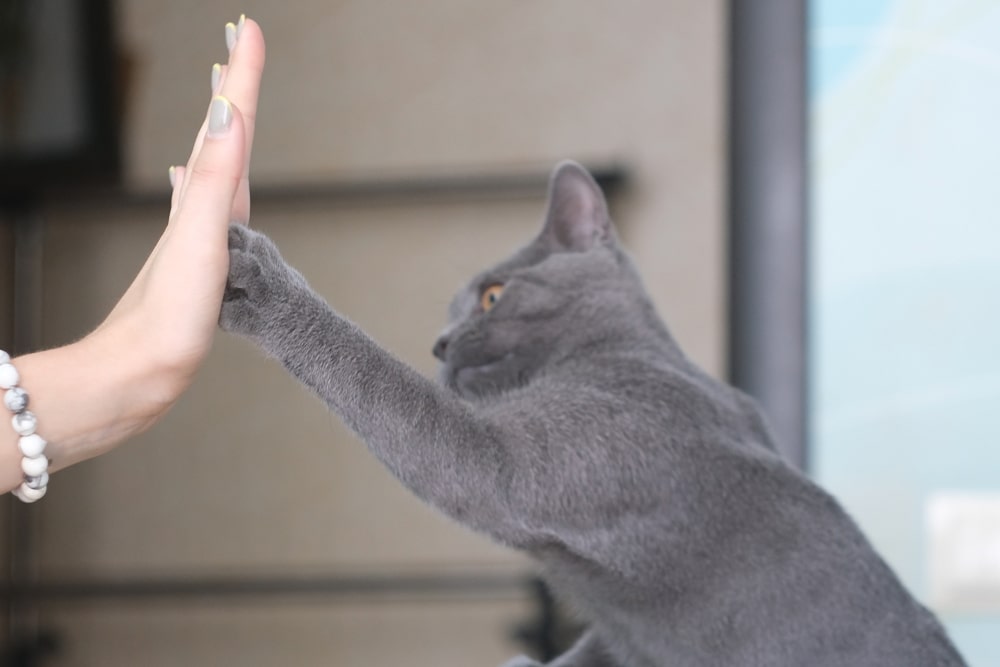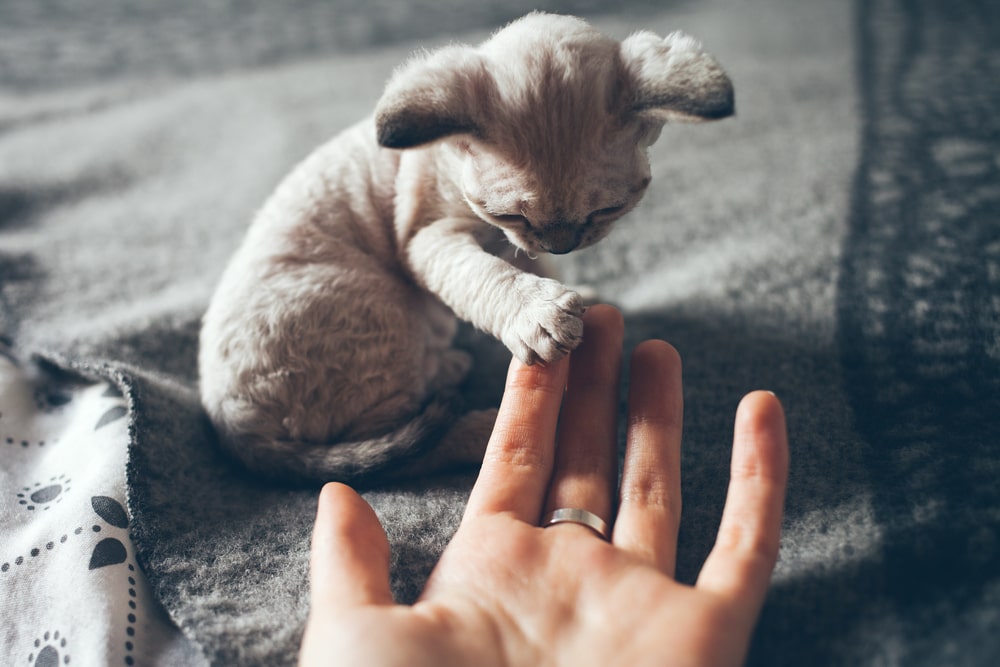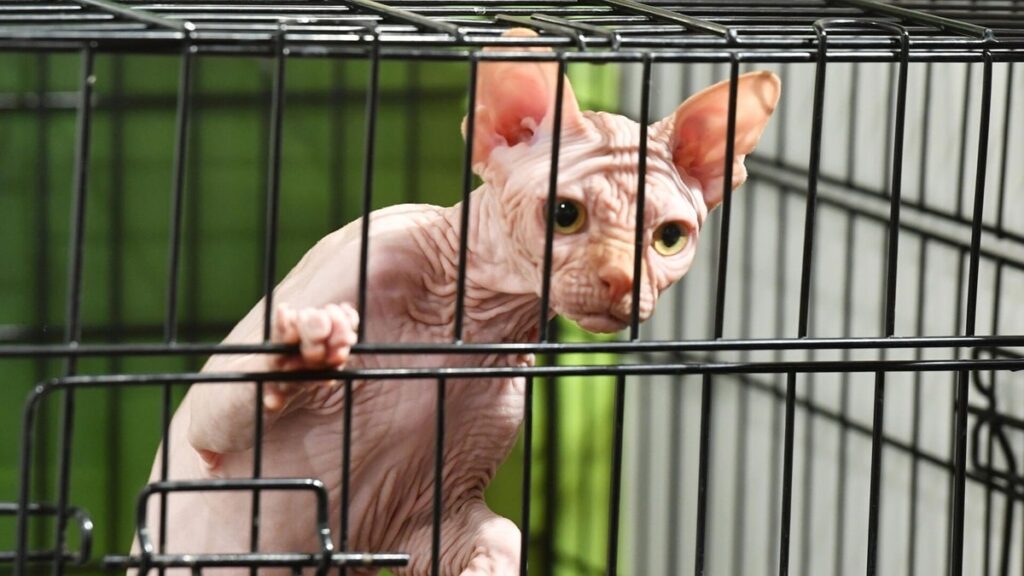How to teach a cat to give a paw: predisposition to training, helpful tips, and common mistakes.
Many owners are convinced that following commands and performing complex tricks is the prerogative of dogs. These animals eagerly learn new things, enjoy the attention of an audience, and instinctively try to please their owner. Their opposite counterparts are free-spirited cats who always do things their own way. If you also believe that you can’t reach an agreement with them, remember Yuri Kuklachev. His theater proves that fluffy pets can also be circus performers. The key is to find the right approach to them. In our article, we will explain how to teach a cat to give a paw, and we will also discuss common mistakes and their solutions.
Is it possible to train cats?
Yuri Kuklachev assures that every cat is talented and can be trained. The problem lies in the fact that not every owner is able to recognize the hidden talent within them.
Predisposition to training.
It is easier to establish a connection and communicate with active and sociable breeds such as Sphynx, Rex, Bobtail, Oriental, Siamese, and Siberian cats. However, there are always exceptions to any rule, as every animal is unique.
It is important to note that the average fluffy pet takes much more time to memorize a command compared to a dog. This has nothing to do with intelligence. The longer training duration is due to the specific characteristics of a cat’s personality and motivation.
Features of intelligence and obedience.
The feline brain is about half the size of the human brain and contains fewer neurons (250 million compared to 16 billion). Despite this, cats rank 5th among the smartest animals. Their strong suit is their ability to perceive visual information, surpassing even humans in this aspect.
The developed visual cortex in the brain enables these furry companions to make decisions based on previous experiences. With regular training, they can be taught to use a toilet and learn various commands.

Short-term memory in cats also deserves attention. It is developed much better than in dogs (16 hours compared to 5) and contributes to the retention of new information. It differs from human memory in selectivity. Cat memory focuses on everything that promotes survival and is of interest to the animal itself. That’s why pets always act according to their own discretion, rather than to please someone else.
The younger the animal, the easier it is to train. The most active memory work is observed in the first 3 years of life.
How to teach a cat the “Shake Paw” command?
You can start training a kitten at 6-8 months of age. At this age, they fully understand the owner’s requirements and can distinguish intonations well.
There are two training options. For the first one, you will need a clicker – a special device that makes a distinct clicking sound when pressed.
With a clicker.
The main advantage of the clicker is its uniqueness and consistency of sound. The click is given immediately after the command is performed and is followed by a mandatory reward. In everyday life, the animal doesn’t hear it, and it quickly associates it with a positive experience.

After acquiring the device, wait for a suitable time for training. If your pet is in a good mood and not occupied with anything else, proceed confidently with the following steps:
- Introduce your cat to the clicker. Click the device and immediately provide a reward. Repeat the exercise several times within a 5-minute period.
- Reinforce the correct response. Repeat the previous exercise until the kitten begins to associate the reward with the clicker. Success can be easily observed by the instinctive licking of the lips after the click.
- Gently take one of the paws in your hand, press the clicker, say the desired phrase, and provide the reward.
- Repeat the previous action until the kitten shows initiative and offers its paw on its own. Once you notice the desired response, immediately press the clicker, say the desired phrase, and provide the reward.
Try to consistently take your pet’s same paw to avoid confusing them accidentally.
As the skill becomes more established, switch the clicker and verbal command, and eventually eliminate the use of the device altogether. This way, your pet will start responding solely to your voice.
Without a clicker.
Training without a clicker is much more challenging. This method of training also yields positive results but requires more patience. Nevertheless, the principle remains the same:
- Hold a tasty reward in one hand and sit in front of the kitten.
- Take the other hand and gently hold one of the paws, say “Give me paw” and reward your pet.
- Repeat the exercise until the initiative is shown and reward only when the cat’s paw is in your hand.
- Once you’ve achieved independent paw reaching, extend your open palm forward, say “Give me your paw,” and wait for the desired response. At this stage, it’s important to reward any attempts, even brief touches.
Do not raise your palm too high and make sure your pet can reach it. Conduct training sessions 2-4 times a day. For faster memorization, you can use shorter versions like “Give” or “Paw.”

Methods of Rewarding.
Unlike dogs, cats are more self-interested. Praise and excitement from the owner are not very motivating for them, although there are exceptions. A more suitable method of rewarding is tasty food.
When choosing treats, focus on their attractiveness and uniqueness. The treat should not be a part of the regular diet. Any small and nutritious snacks from a pet store will do.
At the beginning of the training, provide treats consistently, and towards the end, gradually reduce their quantity but do not eliminate them completely. Cats are very cunning creatures. They quickly lose interest in activities if they don’t see any benefit. Ultimately, the tasty reward should become intermittent so that your pet doesn’t know exactly when it will receive a treat.
Possible errors and issues
If there is a prolonged lack of progress, it is important to check for common mistakes. These may include:
- Holding the paw. Avoid any display of force or coercion.
- Training at a young or old age. Very young kittens not only do not understand your requests, but also constantly get distracted. It is also best to leave elderly animals alone. Their memory is not the same anymore, and their bodies are much more susceptible to stress.
- Punishment for non-compliance or incorrect execution of an action. Success can only be achieved through positive motivation, as the learned trick is only for your benefit.
- Excessive training sessions. Do not exceed the limit of 5 minutes and immediately stop the training if you see signs of fatigue.
- Providing rewarding treats outside of training sessions. Consistently giving tasty food outside of training quickly leads to complete loss of motivation.
- Delayed reinforcement. Don’t hesitate when giving the treat and make sure to keep it with you to deliver it within 1-2 seconds after the desired action is performed. Otherwise, the pet won’t be able to form a strong association.
- Training on a full stomach. Always engage in training sessions before meals. Well-fed animals are not as motivated to work.
- Training immediately after sleep. Do not wake up a sleeping cat and do not disturb it immediately upon waking up. Wait at least 5 minutes to allow the animal to fully wake up and become focused on its surroundings.
Another possible issue is a complete lack of interest. If your pet remains indifferent or shows clear dissatisfaction, simply leave them alone. “Persians” and other breeds with similar temperaments are not easily trained as excessive attention disrupts their focus.

Advanced Command
Once you have achieved the desired result, try to make the current command more challenging and teach your pet to shake different paws. To distinguish between the right and left paw, you can use the phrases “Shake paw” and “Other paw.” The training scheme is as follows:
- Command “Shake paw” and wait for your pet’s right paw to land in your hand.
- Give a treat and praise your pet, then say “Other” and open your other hand.
- Help the left paw reach the desired hand and give a treat.
- Repeat the previous actions until the kitten shows initiative. If it consistently offers the right paw instead of the left one, do not reward this behavior to avoid confusing the animal.
- Regularly perform the exercise until you achieve its perfect execution. This advanced version requires a change in body positioning, so it may take even more time and effort to master.
Conclusion.
Remember that a kitten is not a service dog. Do not place excessive expectations on them and always reward them for any successes, turning the training process into an enjoyable game. If all attempts are in vain, do not despair. Perhaps your cat excels in something else, and it will be much easier for them to excel in fetching, acrobatic jumps, or giving kisses on the lips.
Найкращі практики догляду за хвостиками у 2025.
⚠️ We suggest that you read all the opinions on our portal and take note of them at your own discretion. Do not self-medicate! In our articles we collect the latest scientific data and opinions of authoritative experts in the field of health care. But remember: only a doctor can diagnose and treat.
The portal is intended for users over 13 years old. Some materials may not be suitable for children under the age of 16. We do not collect personal data from children under 13 without parental consent.We have a small request. We strive to create quality content about pet care, and we make it available for free to everyone because we believe everyone deserves accurate and useful information.
Advertising revenue only covers a small portion of our costs, and we want to continue to provide content without having to increase advertising. If you have found our content useful, please support us. It only takes a minute, but your support will help us reduce our reliance on advertising and create even more useful articles. Thank you!


